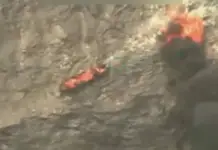With the goal of promoting the responsible use of natural resources, Rancho Las Cacachilas develops productive and educational activities that link livestock, agriculture, and community learning in Baja California Sur.
The ranch’s general manager, José Manuel Pérez Cantú, explained that the ranch does not operate as a tourist ranch, but rather as a working ranch with a productive and educational focus.
“We have various activities such as animal and plant production, and the development of experiences that take the product directly from the farm to the table. Our goal is to preserve South Californian traditions and show how productivity and sustainability can coexist,” he noted.
The ranch consists of different areas, such as Rancho Gaspareño, where the saddle room is located. A collection of saddles was displayed there, and their use in traditional cowboy work was explained.
Hospitality and Tourism Manager Jafet Badillo emphasized the importance of honoring the figure of the South Californian rancher and his historical connection to the arid environment of the peninsula.
“Ranchers have known how to adapt to the desert, find water in times of drought, and maintain their livestock. Here, we want to share a bit of that experience with visitors and show the evolution of local tools and traditions,” he explained.
Badillo explained that the ranch uses mules for field activities and excursions, due to their resilience and adaptation to the terrain. “Mules have been historical allies of the people who came to make their fortune since the 19th century, during the mining and pearl extraction era,” he said.
He also specified that these animals are trained using holistic management techniques that promote animal well-being and soil regeneration.
There is also a vegetable and composting area, where the process of using mule manure to produce compost for crops is demonstrated.
Esmeralda Ramírez, head of production, explained that the ranch applies regenerative agriculture practices, focused on improving soil health and mitigating the effects of climate change.
“We seek to take advantage of available resources, such as mule manure and local organic matter, to create closed production systems. Instead of relying on external inputs, we use what the ecosystem itself offers to maintain soil fertility and biodiversity,” he said.
Ramírez added that these practices not only seek to obtain high-quality food, but also demonstrate that regenerative agriculture is viable in arid ecosystems like Baja California Sur.
“We try to combine the ranchers’ traditional knowledge with new agricultural and irrigation techniques to make the most of natural resources without depleting them,” he added.
Controlled grazing management was explained, in which animals move through sections delimited by electric fences to allow soil recovery and plant regeneration.
This system seeks to balance production with environmental conservation and prevent soil compaction. The area dedicated to the production of goat cheese, one of the ranch’s main products, was revealed.
In this space, the team showed the stables and explained the animal management, which combines daily grazing with supplemental feeding based on forage grown on the ranch.

The area manager explained that management aims to reduce animal stress and strengthen their bond with the herders, which improves milk production.
Milking is currently done using an automated system, although the cheesemaking process remains artisanal and led by women from surrounding communities.
According to Jafet Badillo, 80 percent of the ranch’s staff comes from neighboring communities, making the project one of the main employers in the area.
In addition, the ranch organizes workshops and exchange programs with local producers, universities, and organizations dedicated to rural training.
“We seek to replicate what we learn here on other ranches and communities. Most of our collaborators apply the practices they’ve learned, from bee care to cheese and honey production. It’s a model that combines tradition, innovation, and local collaboration,” Badillo commented.
In the area dedicated to goat cheese production, project staff explained that this is one of the main products produced on-site.
Management of the stables includes daily grazing and supplemental feeding based on forage grown on the ranch, which allows for sustainable, high-quality production.
The ranch, operated by Innovaciones Alumbra, develops a regenerative production model and community collaboration in the southern part of the peninsula. Climate-adaptive agri-food solutions focused on ecosystem regeneration are researched and implemented at the site.
The project integrates agricultural, livestock, and environmental practices that seek to conserve the desert ecosystem and maintain the rural traditions of Baja California Sur, while promoting responsible land and water use.

Source: oem




